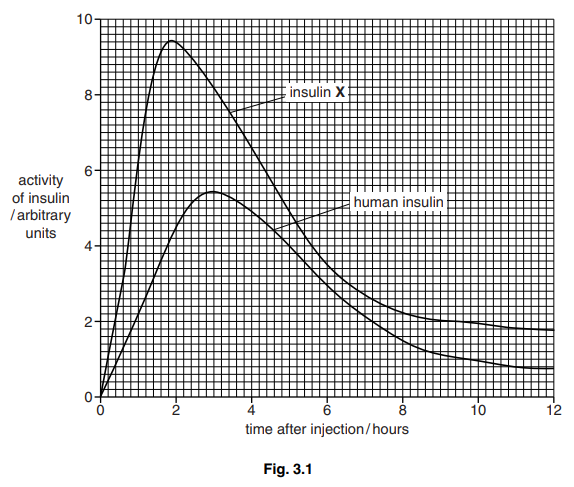Question
Human insulin can be synthesised in a laboratory strain of Escherichia coli using recombinant DNA (rDNA) technology.
The starting point for the process is mRNA coding for insulin, isolated from human pancreas cells.
Four enzymes are needed:
- reverse transcriptase
- DNA polymerase
- restriction enzyme
- DNA ligase.
(a) (i) State the role of each of these enzymes in producing rDNA carrying the gene for human insulin.[4]
reverse transcriptase
DNA polymerase
restriction enzyme
DNA ligase
(ii) Outline the role of insulin in a healthy human.[3]
(iii) Describe and explain one advantage of treating diabetics with human insulin produced by rDNA technology.[2]
(b) It is possible to use rDNA technology to produce insulin with a slightly different structure from that of human insulin. The effect of the changed structure can then be investigated.
The activities of equal quantities of two insulins, both produced by E. coli, were compared in healthy, non-diabetic subjects:
- human insulin
- insulin X, in which the positions of two amino acids, lysine and proline, were exchanged. Lysine has a hydrophilic R group and proline has a hydrophobic R group.
The results of the investigation are shown in Fig. 3.1.

(i) With reference to Fig. 3.1 describe the differences in activity between human insulin and insulin X.[4]
(ii) Suggest how exchanging the position of two amino acids in the insulin molecule can result in differences in activity.[2] [Total: 15]
Answer/Explanation
Ans:
3 (a) (i) reverse transcriptase: produces (c)DNA from mRNA ;
DNA polymerase: produces double stranded DNA from, single stranded (DNA)/ cDNA ;
restriction enzyme: cuts, DNA/plasmid ;
DNA ligase: joins (gaps in) the sugar-phosphate backbone (of DNA) ;
(ii) 1 causes blood glucose concentration, to decrease/return to normal (from high) ;
2 (target cells are) liver/muscle ;
3 increased, absorption of glucose (from blood)/permeability of cell surface membrane to glucose ;
4 increased (rate of) respiration of glucose ;
5 idea of increased conversion of glucose to glycogen ;
6 inhibits secretion of glucagon/decreased gluconeogenesis ;
(ii) 1 identical to that produced by body ;
2 activity the same/fast response/no immune response ;
3 no need for animal insulin/AW ;
4 for religious reasons/for ethical reasons/for e.g. vegetarian ;
5 uncontaminated/pure ;
6 so no risk of disease ;
7 production very efficient/always available ;
8 extraction from animals, costly/ complex/limited by supply of animals ;
(b) (i) insulin X ora throughout for human insulin
1 greater initial increase in activity/AW ;
2 time of maximum activity/peak, earlier ; [1.9h v. 3h]
3 maximum activity/peak, greater ; [9.4 v 5.4 (a.u.)]
4 rate of decrease greater ;
5 activity always higher ;
6 comparative figures ; [see above]
(ii) 1 changes, tertiary/3D structure ;
2 affects binding to receptor (on cell surface membrane) ;
3 (this) affects production of second messenger ;
4 hydrophilic/hydrophobic, bonds different ;
5 AVP ; e.g. may affect, solubility in blood/transport in blood/rate at which broken down
Question
(a) Describe the role of hormones in the maintenance of the human menstrual cycle. [9]
(b) Explain the principles of homeostasis in humans. [6] [Total: 15]
Answer/Explanation
Ans:
10 (a) 1 FSH/LH, released by anterior pituitary ;
2 Graafian/ovarian, follicle develops/AW ;
3 oestrogen produced by follicle (cells) ;
4 oestrogen conc rises for first 12 days ;
5 causes, endometrium to thicken ; A detail such as increase in blood vessels
6 (around day 14) surge in LH/AW ;
7 stimulates ovulation/AW ;
8 corpus luteum develops ;
9 produces progesterone ;
10 causes, further development of endometrium ;
11 if no fertilisation, secretion of FSH/LH inhibited ;
12 corpus luteum, degenerates/AW ;
13 progesterone conc falls ;
14 endometrium breaks down/menstruation occurs ;
15 negative feedback in correct context ;
(b) 1 (homeostasis is) maintenance of, constant/stable, internal environment ;
2 irrespective of changes in external environment ;
3 negative feedback ;
4 ref. to input/ stimulus ;
5 receptor detects change in parameter ;
6 action taken by effector/response/AW ;
7 restoration of, norm/ set point/AW ;
8 ref. to fluctuation around the norm ;
9 example of homeostasis ;
Question
(a) Outline how the oestrogen/progesterone contraceptive pill works to prevent pregnancy. [6]
(b) Discuss the biological, ethical and social implications of using this contraceptive pill. [9] [Total: 15]
Answer/Explanation
Ans:
9 (a) 1 synthetic hormones used ;
2 as they do not get broken down quickly / act for longer ;
3 oestrogen/ progesterone, concentrations remain high ;
4 inhibits secretion of, FSH/ LH/GnRH ; I stops
5 from anterior pituitary gland ;
6 ref. to negative feedback ;
7 inhibits ovulation/no ovulation ;
8 alters cervical mucus to stop sperm ;
9 prevents implantation/ effect on endometrium ;
10 AVP ; e.g. taken daily for 21 days / stops for 7 days to allow menstruation (or) taken daily throughout month.
(b) biological – negative
1 rise in blood pressure/ increased chance of blood clots ;
2 nausea/ headaches ;
3 increased risk of breast cancer ;
4 increase in STDs ;
biological – positive
5 regular/ no menstruation ;
6 reduced risk of developing, ovarian cysts / ovarian cancer/ uterine cancer ;
7 reduced risk of uterine infections ; A pelvic
social/ ethical – negative
8 (sexual freedom has led to) more marriage breakdowns ;
9 (so more) single parent families ;
10 increase in promiscuity ;
11 religious / cultural, objection ;
social/ ethical – positive
12 reduction in, unwanted pregnancies / abortions ;
13 women have control over their fertility ; A ‘bodies’
14 ref. to population control ;
